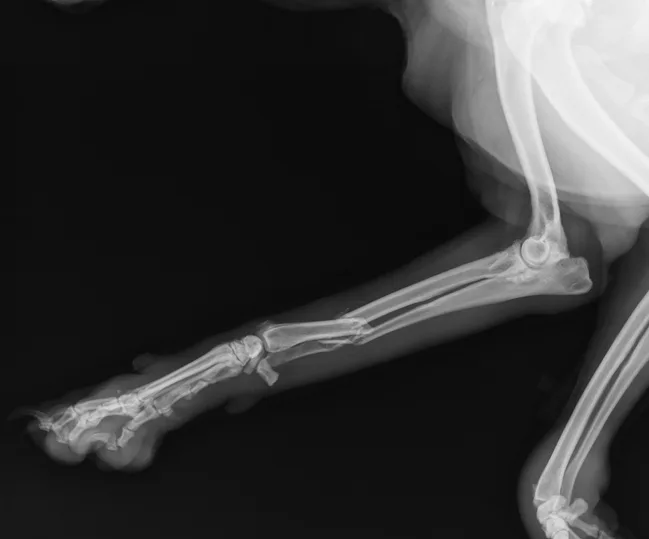
In the Literature
Marshall WG, Filliquist B, Tzimtzimis E, et al. Delayed union, non-union and mal-union in 442 dogs. Vet Surg. 2022;51(7):1087-1095. doi:10.1111/vsu.13880
The Research …
Risk factors for fracture healing complications include mechanical (eg, inadequate stability) and host (eg, disease, medication) factors, excessive fracture gap, bone necrosis, and infection.
This retrospective study investigated the prevalence of delayed union, nonunion, and malunion and determined risk factors for delayed union and nonunion in dogs (n = 442) with appendicular, vertebral, or mandibular bone fractures (n = 461) from 2 referral hospitals in the United Kingdom and United States between 2010 and 2019. Patients with sacroiliac and mandibular symphyseal luxation, tibial osteotomies for cruciate ligament disease, and fractures managed via salvage procedures (eg, arthrodesis, femoral neck ostectomy) were excluded. Fracture characteristics, patient demographics, treatment, outcome, and complications were recorded, and complications were categorized as major or minor.
Median radiographic follow-up was 53 days (range, 14-282). Union (median, 48 days) was recorded in 80.9% of cases. Delayed union, nonunion, and malunion occurred in 13.9%, 4.6%, and 0.7% of cases, respectively. Of the nonunion fractures, 42.9% were successfully revised and progressed to union (median, 208 days after initial injury). The remainder did not progress to union, despite 50% undergoing revision surgery. Malunion cases were managed via open reduction and internal fixation, but all had implant failure.
No individual bone was associated with healing outcome, although the proportion of humeral diaphyseal and Y-fractures with delayed union or nonunion was greater than the proportion of those that healed. Open fractures, comminution, patient age, use of bone graft, infection, and implant failure increased the likelihood of delayed union and nonunion, with comminuted fractures being 4 times more likely to result in delayed union or nonunion. Breed and presence of multiple fractures were not associated with delayed union or nonunion.
… The Takeaways
Key pearls to put into practice:
Close monitoring of bone healing and clinical progression is essential to detect abnormal healing progression or other complications and allow for early management (eg, antibiotic therapy if infection is present, bone-stimulating strategies if delayed healing is suspected, revision surgery if implant failure or nonunion is observed). Pet owners should be informed of these and other potential complications (eg, infection, implant failure) so they can help monitor progress.
Comminuted fractures, increased patient age, bone graft application, infection, and implant failure were associated with increased likelihood of delayed union or nonunion. This study did not support the historical belief of increased risk for delayed union and nonunion in fractures of the radius and ulna in toy breed dogs.1,2
Patients with increased risk for delayed healing or nonunion (eg, senior dogs, dogs with comminuted fractures) may benefit from stronger stabilization constructs and bone grafts during the first surgical intervention, as well as close monitoring during recovery, to decrease risk for healing complications.
You are reading 2-Minute Takeaways, a research summary resource presented by Clinician’s Brief. Clinician’s Brief does not conduct primary research.